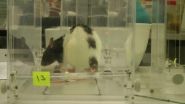(Press-News.org) DALLAS – June 12, 2014 – UT Southwestern Medical Center researchers have generated fresh insights that could aid in the development of rapid-acting antidepressants for treatment-resistant depression.
The researchers found that by blocking NMDA receptors with the drug ketamine, they could elicit rapid antidepressant effects in patients with treatment-resistant depression. Ketamine was developed as an anesthetic, but is better known publicly for its abuse as the party drug Special K. Researchers are now seeking alternatives because ketamine can produce side effects that include hallucinations and the potential for abuse – limiting its utility as an antidepressant.
Therefore, researchers had been investigating a drug called memantine, currently FDA-approved for treating moderate to severe Alzheimer's disease, as a potentially promising therapy for treatment-resistant depression. Memantine acts on the same receptors in the brain as fast-acting ketamine, said Dr. Lisa Monteggia, Professor of Neuroscience. However, recent clinical data suggest that memantine does not exert rapid antidepressant action for reasons that are poorly understood.
"Although, both ketamine and memantine have similar actions when nerve cells are active, under resting conditions, memantine is less effective in blocking nerve cell communication compared to ketamine, This fundamental difference in their action could explain why memantine has not been effective as a rapid antidepressant" said Dr. Monteggia, who holds the Ginny and John Eulich Professorship in Autism Spectrum Disorders.
The different effects of ketamine and memantine alter signals emanating from NMDA receptors, in particular those that determine antidepressant efficacy. Dr. Monteggia noted that the new findings point a way to blocking NMDA receptors to control depression with fewer side effects.
Dr. Monteggia's lab focuses on the molecular and cellular bases of neural plasticity, the fundamental property of nerve cells to alter their communication, as they pertains to neuropsychiatric disorders, as well as understanding the mechanisms underlying antidepressant efficacy.
Guidelines by the American Psychiatric Association suggest medications are the preferred treatment for moderate to severe depressive symptomatology. About one in 10 people in the U.S. aged 12 and over takes anti-depressant medication, and about 14 percent of those individuals taking antidepressant medication have done so for 10 years or longer.
Antidepressants were the third most common prescription drug taken by Americans of all ages between 2005 and 2008, and the most frequently used prescription drug by people 18 to 44 years old, according to surveys by the Centers for Disease Control. According to the CDC, comparing the 1988-1994 period with the 2005-2008 period, the average rate of antidepressant use in the U.S. among all ages increased nearly 400 percent.
Overall, women are two and a half times more likely to take antidepressant medication as men, with 23 percent of women aged 40 to 59 taking antidepressants – more than in any other group.
The CDC estimates that nearly 8 percent of people over age 12 report being currently depressed, with women reporting higher rates of depression than males in every age group. Women between 40 and 59 years have the highest rates of depression (about 12 percent).
Depression generates more than 8 million visits to physician offices, hospital outpatient and emergency departments, and nearly 400,000 in-patient stays, which average 6.5 days.
INFORMATION:
About UT Southwestern Medical Center
UT Southwestern, one of the premier academic medical centers in the nation, integrates pioneering biomedical research with exceptional clinical care and education. The institution's faculty includes many distinguished members, including six who have been awarded Nobel Prizes since 1985. Numbering more than 2,700, the faculty is responsible for groundbreaking medical advances and is committed to translating science-driven research quickly to new clinical treatments. UT Southwestern physicians provide medical care in 40 specialties to nearly 91,000 hospitalized patients and oversee more than 2 million outpatient visits a year.
Researchers uncover new insights into developing rapid-acting antidepressant for treatment-resistant depression
2014-06-12
ELSE PRESS RELEASES FROM THIS DATE:
Good bacteria armed with antibiotic resistance protect gut microbiome
2014-06-12
Researchers from Case Western Reserve University in Cleveland have discovered that populating the gastrointestinal (GI) tracts of mice with Bacteroides species producing a specific enzyme helps protect the good commensal bacteria from the harmful effects of antibiotics. Their research is published ahead of print in Antimicrobial Agents and Chemotherapy.
Antibiotics are powerful weapons against pathogens, but most are relatively indiscriminate, killing the good bacteria, along with the bad. Thus, they may render patients vulnerable to invasion, particularly by virulent, ...
Neural reward response may demonstrate why quitting smoking is harder for some
2014-06-12
For some cigarette smokers, strategies to aid quitting work well, while for many others no method seems to work. Researchers have now identified an aspect of brain activity that helps to predict the effectiveness of a reward-based strategy as motivation to quit smoking.
The researchers observed the brains of nicotine-deprived smokers with functional magnetic resonance imaging (fMRI) and found that those who exhibited the weakest response to rewards were also the least willing to refrain from smoking, even when offered money to do so.
"We believe that our findings may ...
Proteins causing daytime sleepiness tied to bone formation, target for osteoporosis
2014-06-12
DALLAS – June 12, 2014 – Orexin proteins, which are blamed for spontaneous daytime sleepiness, also play a crucial role in bone formation, according to findings by UT Southwestern Medical Center researchers. The findings could potentially give rise to new treatments for osteoporosis, the researchers say.
Orexins are a type of protein used by nerve cells to communicate with each other. Since their discovery at UT Southwestern more than 15 years ago, they have been found to regulate a number of behaviors, including arousal, appetite, reward, energy expenditure, and wakefulness. ...
Long-range tunneling of quantum particles
2014-06-12
This news release is available in German. One of the most remarkable consequences of the rules in quantum mechanics is the capability of a quantum particle to penetrate through a potential barrier even though its energy would not allow for the corresponding classical trajectory. This is known as the quantum tunnel effect and manifests itself in a multitude of well-known phenomena. For example, it explains nuclear radioactive decay, fusion reactions in the interior of stars, and electron transport through quantum dots. Tunneling also is at the heart of many technical ...
Vast genetic diversity among Mexicans found in large-scale study
2014-06-12
The first large-scale, comprehensive analysis of the genomic diversity of Mexico — led by researchers at the Stanford University School of Medicine, the University of California-San Francisco and the Mexican National Institute of Genomic Medicine — has identified a dazzling mosaic of genotypes and population substructures across the country.
Some groups are as genetically different from one another as Europeans are from East Asians.
The study, which will be published June 13 in Science, soundly refutes the current practice of lumping together Mexicans or Latinos as ...
Broad Institute, MGH researchers chart cellular complexity of brain tumors
2014-06-12
Scientists from the Broad Institute and Massachusetts General Hospital (MGH) have conducted a first-of-its-kind study that characterizes the cellular diversity within glioblastoma tumors from patients. The study, which looked at the expression of thousands of genes in individual cells from patient tumors, revealed that the cellular makeup of each tumor is more heterogeneous than previously suspected. The findings, which appear online in Science Express, will help guide future investigations into potential treatments for this devastating disease.
This is the first time ...
Mexican genetics study reveals huge variation in ancestry
2014-06-12
In the most comprehensive genetic study of the Mexican population to date, researchers from UC San Francisco and Stanford University, along with Mexico's National Institute of Genomic Medicine (INMEGEN), have identified tremendous genetic diversity, reflecting thousands of years of separation among local populations and shedding light on a range of confounding aspects of Latino health.
The study, which documented nearly 1 million genetic variants among more than 1,000 individuals, unveiled genetic differences as extensive as the variations between some Europeans and Asians, ...
Father's age influences rate of evolution
2014-06-12
The offspring of chimpanzees inherit 90% of new mutations from their father, and just 10% from their mother, a finding which demonstrates how mutation differs between humans and our closest living relatives, and emphasises the importance of father's age on evolution.
Published today in Science, researchers from the Wellcome Trust Centre for Human Genetics and the Biomedical Primate research Centre in the Netherlands looked at whether, in chimpanzees, there was a heightened risk of fathers passing on mutations to their children compared to humans.
In humans, each individual ...
New evidence for oceans of water deep in the Earth
2014-06-12
Researchers from Northwestern University and the University of New Mexico report evidence for potentially oceans worth of water deep beneath the United States. Though not in the familiar liquid form -- the ingredients for water are bound up in rock deep in the Earth's mantle -- the discovery may represent the planet's largest water reservoir.
The presence of liquid water on the surface is what makes our "blue planet" habitable, and scientists have long been trying to figure out just how much water may be cycling between Earth's surface and interior reservoirs through ...
With the right rehabilitation, paralyzed rats learn to grip again
2014-06-12
VIDEO:
This video depicts Restored grasping after immunotherapy and rehabilitative training.
Click here for more information.
Only if the timing, dosage and kind of rehabilitation are right can motor functions make an almost full recovery after a large stroke. Rats that were paralyzed down one side by a stroke almost managed to regain their motor functions fully if they were given the ideal combination of rehabilitative training and substances that boosted the growth of nerve fibers. ...



